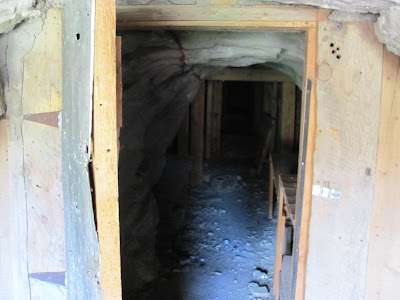
It was here that the Leeds Company opened the surprisingly productive and cleverly named Leeds Mine...


and the equally cleverly named Leeds #2 Mine....

In addition, the Leeds Company opened a 5 stamp mill to handle the ore that was pouring out of the hillside....




In the spirit of competition, the Christy Milling and Mining Company was incorporated in 1877, and they opened a 5-stamp mill of their own...

This peaceful little building was built right at the corner of town, and probably spewed economic smog all over the place. Not much of the mill remains....

By this time the mines were booming, and lots of people who didn't mind crawling down into little holes for a living were required to work them. Luckily for us, the mines in Pioche Nevada had just started to putter out, so everyone from there came rushing over here. This event was big enough to earn the name the "Pioche Stampede" and it was soon noticed that all these people were going to need a place to stay and woo prostitutes. And so begins Silver City, although it was originally named "Rockpile" because it was nothing but tents all over a big pile of rocks. Silver Reef is far more marketable anyway. Here's what the townsite looks like to God and astronauts nowadays!

This map isn't particularly interesting to us. But with a spoonful of imagination and a dumptruck of internet help, maybe we can get a better picture of how the town would have been laid out...

Look at that! The town has sprung to life before our very eyes! Now imagine that you can read the words on that map. If you could, you would see that in 1879 Silver Reef had a booming Chinese population, several saloons, a hospital, schools, and everything else that a miner would need to enjoy themselves. What's that? You wish you could see what Main Street looked like? Well, save your wishes my electronic friend! Behold!

And say you were traveling to Silver Reef, but didn't know what the town looked like from a distance? Well, I can help you out there too...

And for no reason, here's a picture of some guy just leaning and hanging out....

And here's a picture of some sort of old building! Who knows what it was used for? Hat repair? Mule refurbishment? It's a mystery!

Here's an old-timey picture of the two remaining buildings at Silver Reef. The building on the right is the Wells Fargo/Museum building. The one one the left is a house that belongs to one Mr. J.N.Rice. He's probably dead now.

In addition to the two complete structures still standing at Silver Reef, there are several kinda-there structures. Here's the moldering remains of the Harrison House Hotel. That's what happens when you don't tip the room service...

And here's a wall to P. Clancy's store. Shoplifters find this arrangement pretty agreeable.

Aaaand here's the town Skull Fortress.

Just kidding. Silver Reef didn't ever feature a skull fortress. At least not one that anyone has record of. Finally, here are the remains of the Silver Reef Miner's Printing Office.

In all, approximately 1,500 people called this place home by 1879. In addition, several new mines had been discovered along Buckeye Reef....

Included in these new mines was the Hartman Shaft...

The Savage Shaft...

As well as the California Mine....

Just to name a few. These productive mines were joined by several new mine discoveries made along the White Reef, such as the Cobb Mine...


The Nichols Mine....


And finally, the famous Barbee and Walker Mine. The good people at the Barbee and Walker Mine built their own mill at the mine site. See?


I've labeled the stone wall in both pictures for your convenience! I am a merciful blog-guy, am I not? Anyway, that mill burned to the ground in 1879, but was rebuilt and back grinding up ore by 1880. The Barbee and Walker Mine was built using a 30 degree incline that lead down 270 feet to a 3 to 4 foot wide ore zone. Sadly, this mine collapsed a few years after being abandoned, even though it was one of the few mines not constantly battling groundwater. Would these new mines see Silver Reef through to the new century? Or would the fickle nature of nature destroy their hard work, and leave naught but corpses? Stay tuned for Part III!!
4 comments:
Very interesting article. Where did you get the historical images?
Hi Random Scientist! Historical photos were provided by the University of Utah (with permission). I needed to stick that permission part in there. I was going to do that in part III. Ah well.
I am currently writing a book about Silver Reef, and I was wondering how I could get in contact with the U of U to ask permission to use their historical photos?
Hi Random Scientist!
Sorry this has taken so long. I've been really stepping up my napping. I don't recall the name of the lady I talked to up at the U. Let me track down the number I called and I can give that to you.....
Post a Comment